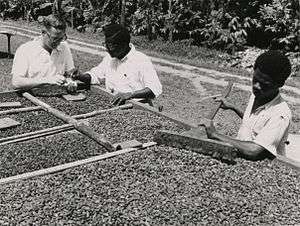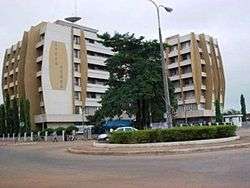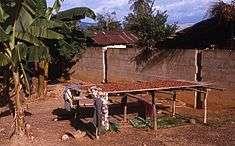Cocoa production in Ghana

Cocoa is the chief agricultural export of Ghana and the country's main cash crop.[1] Behind Ivory Coast, Ghana is the second largest cocoa exporter in the world.[2] Cocoa cultivation is not native to the country;[3] Ghana's cocoa cultivation, however, is noted within the developing world to be one of the most modeled commodities.[4]
Cocoa production occurs in the country's forested areas: Ashanti Region, Brong-Ahafo Region, Central Region, Eastern Region, Western Region, and Volta Region, where rainfall is 1,000-1,500 millimeters per year. The crop year begins in October, when purchases of the main crop begin, with smaller mid-crop cycle beginning in July. All cocoa, except that which is smuggled out of the country, is sold at fixed prices to the Cocoa Marketing Board. Although most cocoa production is carried out by peasant farmers on plots of less than three hectares, a small number of farmers appear to dominate the trade. Indeed, some studies show that about one-fourth of all cocoa farmers receive just over half of total cocoa income.[5]
In 1979, the government initiated reform of the cocoa sector, focusing on the government's role in controlling the industry through the Cocoa Marketing Board. The board was dissolved and reconstituted as the Ghana Cocoa Board (Cocobod). In 1984 it underwent further institutional reform aimed at subjecting the cocoa sector to market forces. Cocobod's role was reduced, and 40 percent of its staff, or at least 35,000 employees, were dismissed. Furthermore, the government shifted responsibility for crop transport to the private sector. Subsidies for production inputs (fertilizers, insecticides, fungicides, and equipment) were removed, and there was a measure of privatization of the processing sector through at least one joint venture. In addition, a new payment system known as the Akuafo Check System was introduced in 1982 at the point of purchase of dried beans. Formerly, produce buying clerks had often held back cash payments, abused funds, and paid farmers with false checks. Under the Akuafo system, a farmer was given a check signed by the produce clerk and the treasurer that he could cash at a bank of his choice.
Plantation divestiture proceeded slowly, however, with only seven of fifty-two plantations sold by the end of 1990. Although Ghana was the world's largest cocoa producer in the early 1960s, by the early 1980s production had dwindled almost to the point of insignificance. The drop from an average of more than 450,000 tons per year to a low of 159,000 tons in 1983-84 has been attributed to aging trees, widespread disease, bad weather, and low producer prices. In addition, bush fires in 1983 destroyed some 60,000 hectares of cocoa farms, so that the 1983-84 crop was barely 28 percent of the 557,000 tons recorded in 1964-65. Output then recovered to 228,000 tons in 1986-87. Revised figures show that production amounted to 301,000 tons in 1988-89, 293,000 tons in 1990-91, and 305,000 tons in 1992-93. After declining to 255,000 tons in 1993-94, the crop was projected to return to the 300,000 ton range in 1994-95.[5]
In the early 1990s, Cocobod continued to liberalize and to privatize cocoa marketing. The board raised prices to producers and introduced a new system providing greater incentives for private traders. In particular, Cocobod agreed to pay traders a minimum producer price as well as an additional fee to cover the buyers' operating and transportation costs and to provide some profit. Cocobod still handled overseas shipment and export of cocoa to ensure quality control.[5]
In addition to instituting marketing reforms, the government also attempted to restructure cocoa production. In 1983 farmers were provided with seedlings to replace trees lost in the drought and trees more than thirty years old (about one-fourth of the total number of trees in 1984). Until the early 1990s, an estimated 40 hectares continued to be added to the total area of 800,000 hectares under cocoa production each year. In addition, a major program to upgrade existing roads and to construct 3,000 kilometers of new feeder roads was launched to ease the transportation and sale of cocoa from some of the more neglected but very fertile growing areas on the border with Ivory Coast. Furthermore, the government tried to increase Ghana's productivity from 300 kilograms per hectare to compete with Southeast Asian productivity of almost 1,000 kilograms per hectare. New emphasis was placed on extension services, drought and disease research, and the use of fertilizers and insecticides. The results of these measures were to be seen in rising cocoa production from the 1990s to the present.[5]
Recent growth
Ghana's cocoa production grew an average of 16% between 2000–03.[6] Cocoa has a long production cycle, far longer than many other tropical crops, and new hybrid varieties need over five years to come into production, and a further 10 to 15 years for the tree to reach its full bearing potential. The reasons for this huge production increase are varied and in fact Ghana's cocoa yields per hectare are still low by international standards.[6] Researchers at the Overseas Development Institute identify the following as particularly important:[6]
- Land
- Labour
- Fertiliser
- Insecticide
- Agricultural equipment
- Western Sefwi (suggesting smuggling from Ivory Coast)
- Rainfall
- Male cocoa farmer
- Use of spraying machine
This study also suggests that the most important factors in the increased production are:[6]
- New land brought under cultivation
- More intensive use of household labour
- A good rainfall pattern
- Effectiveness of farm spraying and increased fertiliser use
This study suggests that Ghana's cocoa farmers are not making the best use of technological innovations in their production and instead their increased production is not sustainable.[6] Bringing new land under cultivation is risky, as much of the land was previously forest and after a short period and without adequate attention this land may be exhausted. Intensive use of labour has led to high increases in the cost of labour and may impact profitability, and high rainfall is only periodic.[6]
Hybrid system of liberalisation

Ghana Cocoa Board's experimentation with privatisation has created a hybrid system whereby despite all exports being controlled by the state, there are now around 25 private companies buying the crop in all areas of the country where it is grown.[7] After 14 years, the successes and failures of this hybrid system have been the subject of a study by researchers at the Overseas Development Institute. Competition was clearly found to have increased production levels throughout the country, yet access to credit remained one of the most important factors determining the level of competition. Farmers rarely made the most of all the available options to sell their crop (often they only made use of one).[7] Their choice was based on the ability of a company to pay promptly in cash and thus there were only five major players on the market: PBC (formerly state-owned), Kuapa Kokoo (a hugely successful farmers-based cooperative working on fair trade principle), Adwumapa (a Ghanaian buying company), Olam and Armajaro (both foreign-owned companies, from Singapore and the UK respectively).[7] Another key determining factor is the distance of the plantation from the main market, as more remote farms more often found it easier to sell to the formerly state-owned PBC.[7]
This hybrid scheme benefits a variety of players:[7]
- The state, which maintains a monopoly on all exports and makes a substantially higher return from taxation than other cocoa regions;
- The traders, who compete for the purchase of higher volumes of the export crop on non-price terms throughout the cocoa belt areas; and
- The farmers, who are guaranteed a minimum floor price regardless of their geographical location.
Researchers at the ODI therefore suggest that liberalisation has been good for producers by:[7]
- providing farmers with more choice of buyers;
- delivering cash payments promptly; and
- maintaining stability in producer prices throughout the season.
Yet the question remains for policy-makers as to the benefits of the state controlling an export monopoly and its strong presence of the public sector in the internal market, whether there should be even more liberalisation, and whether it is providing the right incentives for producers to develop better (and sustainable) farming practices.[7]
References
- ↑ "Supply Chain Risk Assessment: Cocoa in Ghana". Forum for Agricultural Risk Management in Development. Retrieved 21 September 2013.
- ↑ "UPDATE 1-Ghana signs $1.2 bln cocoa loan for 2013/14 crop purchases". Reuters. September 20, 2013. Retrieved 21 September 2013.
- ↑ Salm & Falola 2002, p. 15.
- ↑ Bulir 1998, p. 4.
- 1 2 3 4 Clark, Nancy L. "Agriculture" (and subchapters). A Country Study: Ghana (La Verle Berry, editor). Library of Congress Federal Research Division (November 1994). This article incorporates text from this source, which is in the public domain.
- 1 2 3 4 5 6 Marcella Vigneri 2007 Drivers of cocoa production growth in Ghana Overseas Development Institute
- 1 2 3 4 5 6 7 Marcella Vigneri and Paulo Santos 2007 Ghana and the cocoa marketing dilemma: What has liberalisation without price competition achieved? Overseas Development Institute
- Bibliography
- Bulir, Ales (1 June 1998). The Price Incentive to Smuggle and the Cocoa Supply in Ghana, 1950-96. International Monetary Fund. ISBN 978-1-4518-9707-4.
- Salm, Steven J.; Falola, Toyin (1 January 2002). Culture and Customs of Ghana. Greenwood Publishing Group. ISBN 978-0-313-32050-7.

